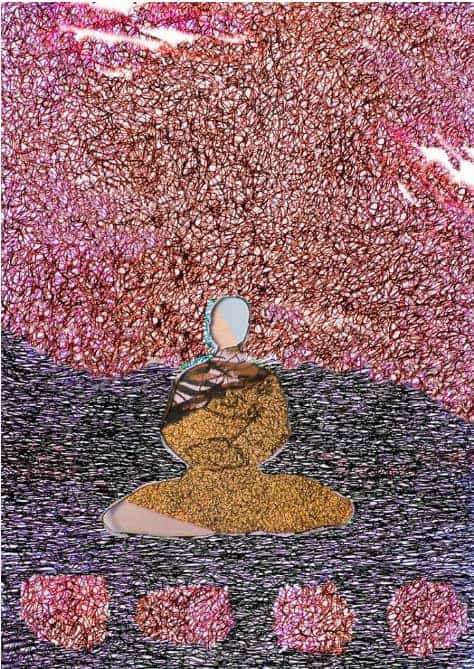
The other day, I spontaneously drew a meditating figure sitting in a stream. Looking at it later, I wondered why I’d placed a contemplating person in the water. Suddenly, it made sense to me because Buddha-consciousness constantly adjusted to the ever-changing flow of life. No matter what circumstances might drift along and engulf a person, equanimity and joy were possible.
As I continued to gaze at my completed drawing, I gained insight. In the river, I’d placed four rocks that, I came to realize, represented the obstacles people commonly face, such as challenging relationships, illness, old-age and death. The Buddha serenely contemplated the stones, allowing them to remain as they were. This attitude of acceptance and peace inspired me.
When I experience conflict, contemplation helps. Although my heart might ache when I suffer or see others in hardship, meditation assists me to release my ego from the situation. At the best of times, I can minimize arguing, defensiveness and judgment, a relief for all concerned. However, I can still backslide at times, as recently occurred.
A few weeks ago, I got upset and found myself wanting to mentally condemn someone who was nasty to a relative. I got so emotionally involved in the drama, even a fragment of peace seemed impossible to attain.
Luckily, I remembered constructive steps I could take. I had heart-to-heart talks with the people concerned, discussed possible solutions, sought advice from trusted advisors, wrote in my journal and contemplated all the possibilities. I set the boundaries I needed to take good care of myself. When I found my mind still embroiled in the controversy, I turned to meditation. It took a week of practice to calm myself, to loosen my ego’s grasp. It worked. At last, my mind could, bit by bit, stop blaming and complaining. I began to feel detachment combined with love and compassion for those in conflict, even the aggressor (much to my surprise).
While the on-going clash between the parties makes me sad, I can achieve a peaceful inner world which makes it easier for me to search for positive solutions, rather than accuse and judge. This is hard work.
In my drawing, a shawl-like shape covers the shoulders of the contemplative figure. I often feel a chill in that area of my body and I want my Buddha to have a source of warmth in the stream. I love the symbolism, for, to me, the shawl signifies spiritual protection and comfort.
The head has a diagonal division across it which represents dualistic thinking: right-wrong, past-future, good-bad. It’s my aspiration, like the Buddha, to anchor myself in objective perceptions, free of black-and-white thinking with the ego-based condemnations I observe in myself and others.
In the river of life, I can’t always avoid conflicts that flow around and through me. Drawing the Buddha contemplating these difficulties with impartiality helps me to do the same.
Buddha in a Stream at Sunset is featured in the Walter Wickiser Gallery’s current exhibit, Gallery Artists Part XX, celebrating twenty years of exhibition in this New York gallery. The exhibit opens June 21st. See it online at the Walter Wickiser website until September 23rd: www. walterwickisergallery.com
Kaethe Kauffman’s one-person exhibit, La Foresta, is at Castello Gallery 780 in Venice, Italy, April 19 to June 23, 2024. Castello Gallery 780 is affiliated with the Venice Biennale art fair.
